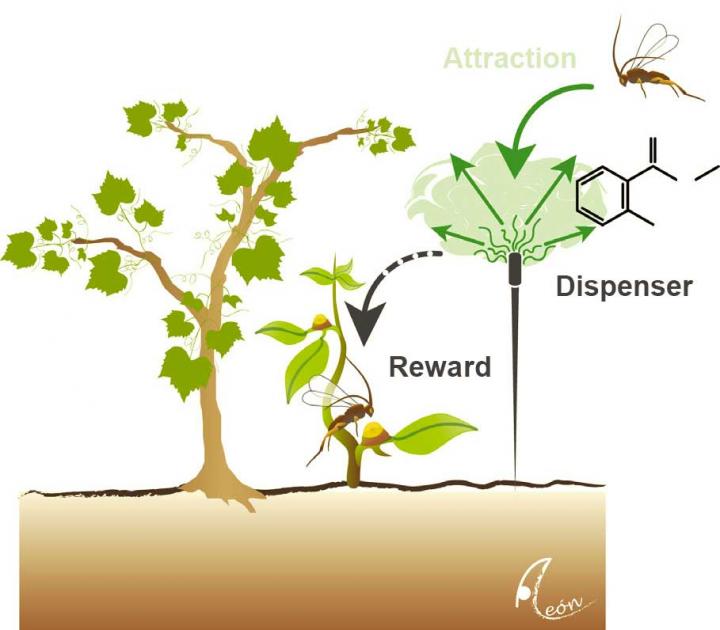Wild plants call to carnivores to get rid of pests — could crops do the same?

This diagram shows how nectar can enhance the survival and efficiency of predators and thus allow the establishment of more stable populations of these biocontrol organisms. Credit: Stenberg et al./Trends in Plant Science 2015
While this strategy may work in someone's backyard, it's not an option on a large farm. In an October 4 Trends in Plant Science Opinion paper, agricultural researchers in Sweden and Mexico argue that one way around the scalability problem is to bring back the odors and nectars found in wild plants that attract pest-eating predators. This could be done either through breeding programs or by using artificial devices.
“Wild plants commonly emit natural odors when they are damaged that attract natural enemies of pest insects–even as humans we smell it when our neighbour is mowing the lawn – odors can carry very precise information,” says co-author Martin Heil of CINVESTAV-Irapuato in Mexico.
“Agriculture has bred such defenses out of crops, and since these odors have no negative effects on human consumers, we want to replace what the plant would already be doing.”
It's also not unusual for wild plants to produce nectar on their leaves to feed carnivores. While leaf-eating caterpillars or beetles are munching away on plant matter, predatory ants or wasps have a sugary substance to drink and a well-stocked spot to lay their eggs.
Heil and others theorize that the reason these rather helpful traits no longer exist in crops is because plant breeders and decision makers couldn't tell the difference between helpful insects and pests. Only in the past 30 years has it been recognized that plants use odors to communicate to one another and to other species. Such defenses involve multiple genes, however, and it won't be easy to simply bring them back.
One faster alternative would be to plant crops alongside other species that both attract carnivores and repel pests. The downside is that intercropping requires more work during harvesting and its success rate isn't 100%. Another option is to create mechanical dispensers that could release carnivore-calling odors and fungicidal nectar, which is something Heil and his team are now developing and testing.
“New regulations and changing consumer demands are gradually improving the prospects for more sustainable agriculture,” Heil says. “This provides a ready market if we can give crops back their own immune system, either by breeding, genetic engineering, or replacing the traits artificially.”
###
The authors receive funding from the Swedish research council Formas, CONACyT, the Swedish Energy Agency, the SAMBA project, the Future Forests Project, and the Swedish University of Agricultural Sciences.
Trends in Plant Science, Stenberg et al.: “Optimizing Crops for Biocontrol of Pests and Disease” http://dx.
Trends in Plant Science (@TrendsPlantSci), published by Cell Press, is a monthly review journal that features broad coverage of basic plant science, from molecular biology through to ecology. Aimed at researchers, students, and teachers, its articles are authoritative and written by both leaders in the field and rising stars. For more information, please visit http://www.
Media Contact
All latest news from the category: Life Sciences and Chemistry
Articles and reports from the Life Sciences and chemistry area deal with applied and basic research into modern biology, chemistry and human medicine.
Valuable information can be found on a range of life sciences fields including bacteriology, biochemistry, bionics, bioinformatics, biophysics, biotechnology, genetics, geobotany, human biology, marine biology, microbiology, molecular biology, cellular biology, zoology, bioinorganic chemistry, microchemistry and environmental chemistry.
Newest articles

Silicon Carbide Innovation Alliance to drive industrial-scale semiconductor work
Known for its ability to withstand extreme environments and high voltages, silicon carbide (SiC) is a semiconducting material made up of silicon and carbon atoms arranged into crystals that is…

New SPECT/CT technique shows impressive biomarker identification
…offers increased access for prostate cancer patients. A novel SPECT/CT acquisition method can accurately detect radiopharmaceutical biodistribution in a convenient manner for prostate cancer patients, opening the door for more…

How 3D printers can give robots a soft touch
Soft skin coverings and touch sensors have emerged as a promising feature for robots that are both safer and more intuitive for human interaction, but they are expensive and difficult…





















